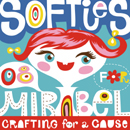I really should have taken a before photo, but I got so into ripping it out that it totally slipped my mind, so just imagine that all of that dirt area was covered with blue periwinkle. It's a pain to clear because it grows in tight nodes and you have to rip out the roots or the fragments just grow back.
"Spreads locally mainly by stems that root at nodes. Seed is apparently rarely produced in Australia. Long distance dispersal occurs via stem fragments and crowns dispersed as garden waste or by water."But we're slowly getting there. It's all down the side of the house as well. Our very ambitious Grand Ultimate Plan is for the plants in our garden to be indigenous, or at least native. It's amazing how quickly extra birds and pretty butterflies come through the backyard just by adding a few more local plants. There are a few remnant patches nearby and there are local parks and waterways, maintained by local environmental groups, that we're getting some inspiration from.
We have a few ferns leading down to the backyard (the property is on a hill) and we thought it would be totally awesome to have bracken (Pteridium esculentum) growing in the more dry parts of the backyard, to keep the continuity in the backyard and because it's indigenous. Although I have no idea where to get bracken - you can't just buy it because it grows from spores and doesn't take so well to transplantation. And strangely enough, many people think it's a weed (mostly stemming from farmers' dislike of it because it makes their cattle ill) so there are many websites on the struggles on how to remove it (once the spores are settled, it's hard to remove), but not how to get actually some in your backyard.
Failing on the bracken idea, we might just trawl the list of indigenous plants supplied at Kuranga and see what we can buy.



















4 comments:
Sounds fantastic! In my little house with bricked backyard (augh! augh!) I will live vicariously and dream of a day when we can create an indigenous garden, too.
Good luck with the project. They're big projects gardens. It's been five years, but slowly mine is taking shape and I can see more clearly what I want done. Front is natives and a bit of the garden's existing plantings (I am a sucker for a little bit of garden history) and the back is edible and a wee bit tropical (again because of what was already there). I'm not one for ripping out serviceable happy plants for the sake of whimsy. I kind see people who knock down existing places to build McMansions in the same category. So, it's an eclectic mix that will never be what I'd choose if given a bare block of land, but it's got character.
Katie: I know, it annoys me too when I walk around our local area, and seeing whole blocks of land get flattened with all of their trees. There are still lots of non-native plants around, like we've got a big silky oak, and things like that. It's just a case of, when one thing dies then we replace it with something local. Yes, it's a very long term Grand Ultimate Plan indeed!!
Good luck with ripping out the periwinkle. Reminds of the time we started ripping out ivy from my parents house. Did you know that you can also pull the motar from between bricks with ivy? Tough stuff!
I enjoyed looking at the link to Kuranga too. I have never been, but I think I might need to make a trip soon. When we bought our house it was full of cottage plants (and the drought is gradually killing them off). Natives are the way to go.
Post a Comment